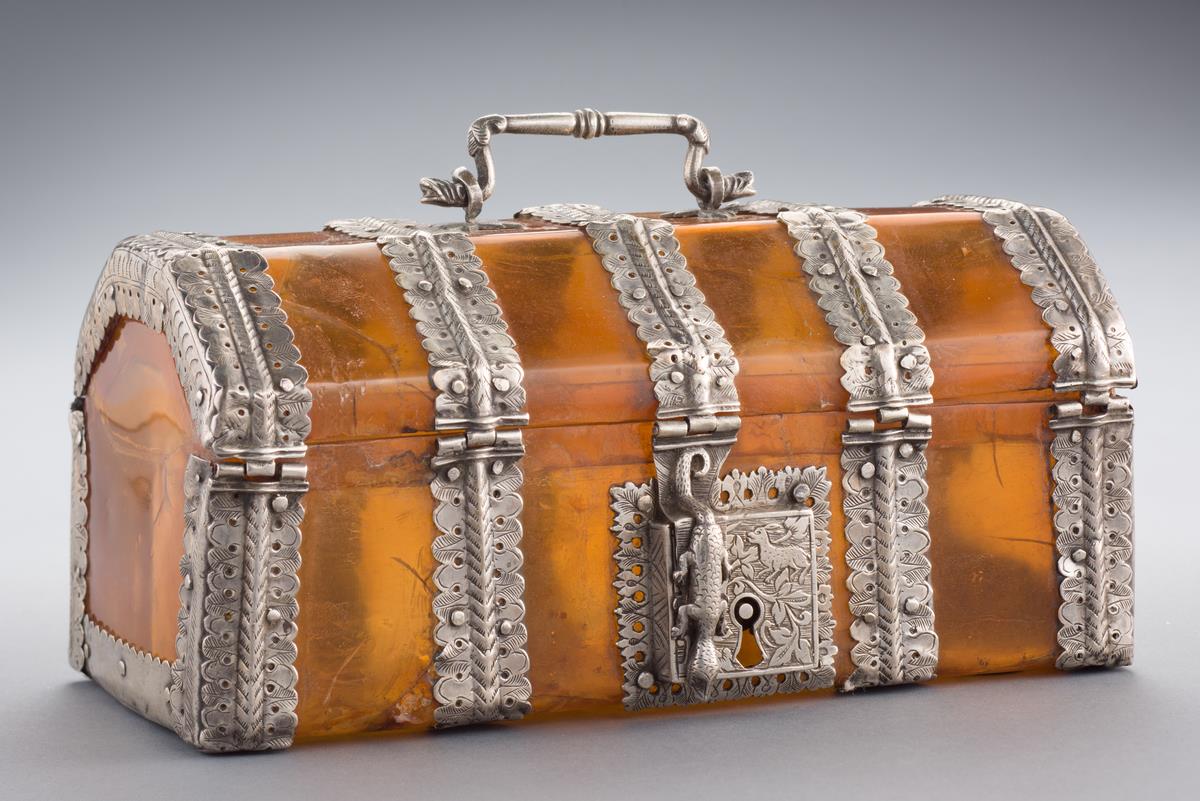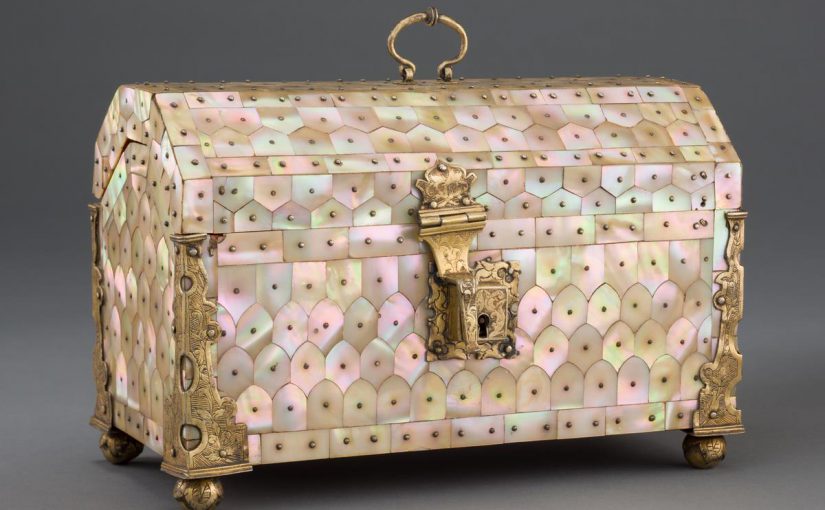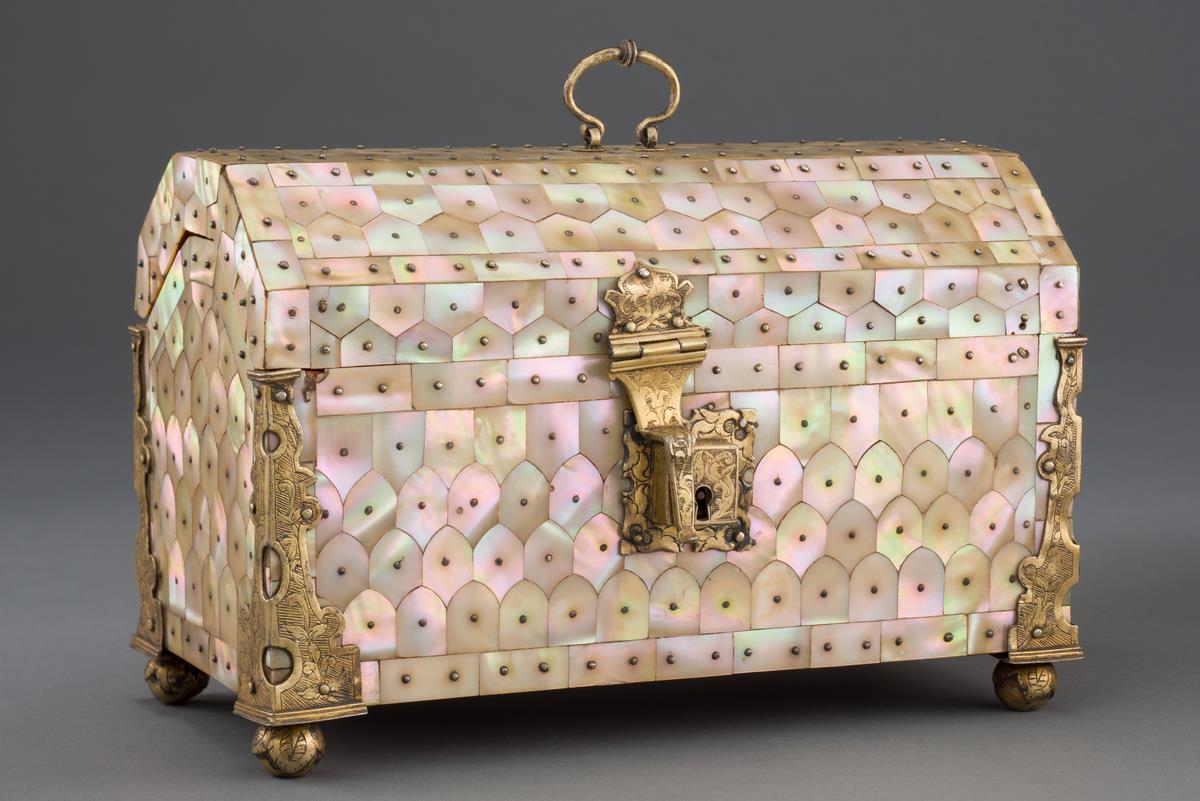Contextual analysis

Mother-of-pearl casket, Gujarat, India, 16th Century
Made of teak and overlaid with mother-of-pearl using ‘small gilded silver nails’[1], it can be suggested that this casket was to be made for local use or export to global markets such as Europe[2]. The style and techniques used in the Mother-of-pearl Casket can be speculated to be a mix of influences — from Europe due to the ‘finely engraved gilded silver appliqués on the sides’ and also traditional Gujarat. Mother-of-pearl as a material was attractive due to its iridescent quality. Caskets such as the one in focus were speculated to be used as reliquaries, or to store jewelry[3], while other sources mention that some of them may have been used just for display.
European presence in the Mughal Empire and Gujarat, India
Europe’s access to the Islamic World was mostly through trade. Portuguese, Dutch, English and French merchants made their way to the Empire in the late fifteenth century, enticed by the prosperity that could be attained by the export of luxury goods to the European market. They were supported by the Mughal and Safavid governments, which wanted trade partners to boost the economy. The Portuguese arrived in India in 1498, but the British, ‘under the aegis of the East India Company, would prove to be the chief force in the subcontinent.’
Indian arists in the Mughal empire acquired the techniques used of ‘modeling and spatial recession’ that they used in application to their own crafts via referencing the engravings of sixteenth century illustrated Bibles introduced by Jesuit missionaries.[4]
In the sixteenth and seventeenth centuries, Gujarat, in western India, was the main producer of a variety of objects inlaid or made with mother-of-pearl. The main attractiveness of mother-of-pearl was due to its iridescent quality. Gujarat was first named as the main produce of mother-of-pearl craft in 1502, in which on the African East Coast, the King of Melinde presented Vasco da Gama with “a Bedstead of Cambay, wrought with gold and mother-of-pearl, a very beautiful thing”. In the context of Europe, the mother-of-pearl from India made its debut in the royal collections of the Portuguese.[5]
Mother-of-pearl: origins and techniques
Mother-of-pearl is made of ‘thin, flat calcium-carbonate plates secreted by certain bivalve mollusks (as well as cuttlefish and snails) and arranged in layers around the inside of the shell.’ The luminous colors of the mother-of-pearl are the culmination of light refracted through the multiple layers of the plates. The most well-known source of mother-of-pearl is the large saltwater pearl oyster (Aricula margaritifera or Meleagrina margaritafera), found largely in the Red Sea, Persian Gulf, the Indian Ocean, South China Sea, Celebes Sea and North Pacific Ocean at a depth of 10-70 metres.
Mother-of-Pearl is a soft, malleable material, and thus can be either dissolved in acid or hand carved, then ‘polished with abrasives or acid to regain its luster’.[6] The use of mother-of-pearl in carvings expanded after the mid-fifteenth century. Majority of works made with the material are ‘circular or polygonal in form, occasionally pierced or in the plique à jour style’.[7] It can be speculated that the plique à jour style was used in the Mother-of-Pearl Casket, where the application of mother-of-pearl is in cells on top of the base backing made out of wood. The material could be applied to a variety of surfaces as it was durable and strong enough to be laid in pieces over a wooden body or could be used to produce smaller items such as cups and bowls.
Gujarat’s mother-of-pearl can be grouped in two classifications. The Casket in focus is classified in the first group – objects with are either made of wood, with inlays of mother-of-pearl over the entire structure. The second group consists of objects made of wood and ‘covered with a dark mastic inset with pieces of mother-of-pearl in vegetal, geometric and, less frequently, figurative designs.’ From a close examination of physical objects from both groups, it can be said that the two techniques of the groups influenced each other and may have been made in the same location; ‘that there exists a small group of objects that has both mastic-inset and overlaid mother-of-pearl also suggests that craftsmen working in the two techniques collaborated or deliberately worked in each others’ style.’ [8]
Other similar objects of interest made in Gujarat, India

Tortoiseshell casket, 16th century, Gujarat, India
Like the mother-of-pearl casket, this tortoiseshell casket was made in Gujarat, India in the same era. The casket is crafted with tortoiseshell, which are linked together by ‘vertical bands of silver mounts around the body’. Similarities can be drawn between this tortoiseshell casket and the mother-of-pearl casket – both caskets have similar features: the apparent European influences derived from their rectangular body and lid, as well as silver appliqués on the sides. Similar to the mother-of-pearl, tortoiseshell articles were a ‘specialty of Gujarat in western India’ and they functioned as reliquaries as well.
Takeaway
The European influences apparent in caskets made in Gujarat suggest that most caskets were used as exports to global markets, especially to Europe and Portugal. The caskets had multiple functions – for display, jewelry storage and as reliquaries to store precious religious objects. As such, they were of prized luxury articles and were highly likely commissioned by royalty or churches of those markets.
Footnotes
[1] Asian Civilisation Museum. Mother-of-pearl casket.
https://roots.sg/learn/collections/listing/1064555
[2] V&A Collections. Casket.
http://collections.vam.ac.uk/item/O17094/casket-unknown/
[3] Asian Civilisation Museum. Mother-of-pearl casket.
[4] Metmuseum. “Europe and the Islamic World, 1600- 1800.”
Accessed 10 November 2018. Retrieved from https://www.metmuseum.org/toah/hd/erpr/hd_erpr.htm
[5] V&A Collections. Casket.
[6] Slatner-Prückl, Michaela. “Mother-of-pearl”. Grove Art Online.
Accessed 10 November 2018. Retrieved from
http://www.oxfordartonline.com.ezlibproxy1.ntu.edu.sg/groveart/view/10.1093/gao/9781884446054.001.0001/oao-9781884446054-e-7000059895
[7] Slatner-Prückl. “Mother-of-pearl”
[8] V&A Collections. Casket.
Bibliography
Mother-of-Pearl Casket
https://roots.sg/learn/collections/listing/1064555
Tortoiseshell Casket
https://roots.sg/Roots/learn/collections/listing/1316074
Slatner-Prückl, Michaela. “Mother-of-pearl”. Grove Art Online.
Accessed 10 November 2018. Retrieved from
http://www.oxfordartonline.com.ezlibproxy1.ntu.edu.sg/groveart/view/10.1093/gao/9781884446054.001.0001/oao-9781884446054-e-7000059895
Metmuseum. “Europe and the Islamic World, 1600- 1800.”
Accessed 10 November 2018. Retrieved from https://www.metmuseum.org/toah/hd/erpr/hd_erpr.htm
Göttler, C. and Mochizuki, M. “The Nomadic Object: The Challenge of World for Early Modern Religious Art” pp 400
Accessed 1 November 2018. Retrieved from
https://books.google.com.sg/books?id=uyk_DwAAQBAJ&pg=PA400&lpg=PA400&dq=mother+of+pearl+casket+india&source=bl&ots=oOlMJgZNZ7&sig=EN5Ld87luvU3OjxjBDKI52lBgk4&hl=en&sa=X&ved=2ahUKEwju4tW1nbLeAhUOfn0KHRurDks4ChDoATABegQIARAB#v=onepage&q=mother%20of%20pearl%20casket%20india&f=false
Carvalho, Pedro M. “What Happened to the Mughal Furniture? The Role of the Imperial Workshops, the Decorative Motifs Used, and the Influence of Western Models”
Accessed 1 November 2018.
Retrieved from
https://www-jstor-org.ezlibproxy1.ntu.edu.sg/stable/pdf/1523346.pdf?refreqid=excelsior%3A704631e465b435145f67e54462282a46
V&A Collections. Casket.
http://collections.vam.ac.uk/item/O17094/casket-unknown/
V&A Collections. Tortoiseshell Casket.
http://collections.vam.ac.uk/item/O70805/casket-unknown/

